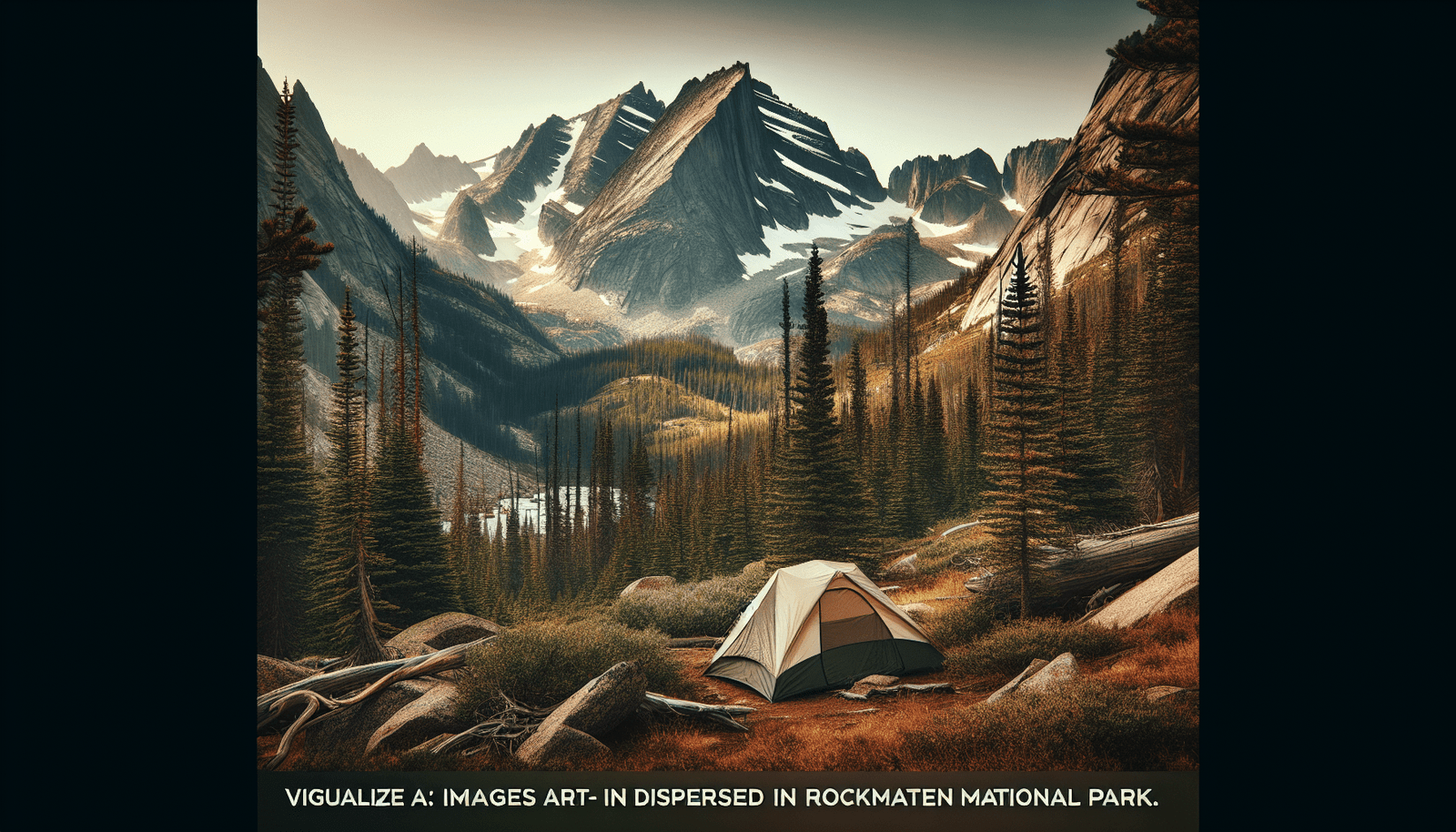Imagine setting up your tent in the heart of the stunning Rocky Mountain National Park, surrounded by breathtaking vistas and the serene sounds of nature. “Is There Dispersed Camping In Rocky Mountain National Park?” explores the possibilities and restrictions of finding that perfect, secluded camping spot within this majestic wilderness. Whether you’re an avid camper or a curious explorer, this article will guide you through the ins and outs of dispersed camping options in and around the park, ensuring you have all the information you need for an unforgettable outdoor adventure. Have you ever wondered if there is dispersed camping in Rocky Mountain National Park? If so, you’re not alone. Many nature enthusiasts and adventurers like yourself have pondered this very question. Whether you’re new to camping or a seasoned outdoorsperson, understanding where you can and can’t set up camp in this iconic national park is crucial for a great outdoor experience. Let’s dive into the nitty-gritty details together!
What is Dispersed Camping?
To kick things off, let’s clarify what dispersed camping actually is. Dispersed camping means setting up your tent or park your RV outside of designated campgrounds. It’s a more rugged and often quieter experience compared to traditional campground camping. This type of camping typically lacks the amenities you’re used to, like toilets, picnic tables, and fire rings, giving you a more “back-to-nature” experience.
The Basics of Camping in Rocky Mountain National Park
Rocky Mountain National Park, located in Colorado, is a breathtaking expanse of wilderness featuring towering peaks, lush forests, and stunning alpine lakes. Managed by the National Park Service (NPS), this park has specific rules and regulations to preserve its natural beauty and ensure the safety of its visitors.
Designated Campgrounds
First things first, Rocky Mountain National Park has five designated campgrounds:
- Aspenglen Campground
- Glacier Basin Campground
- Moraine Park Campground
- Timber Creek Campground
- Longs Peak Campground
If you prefer amenities such as restrooms, picnic tables, and potable water, these campgrounds are your best bet. Reservations for these campgrounds can fill up quickly, especially during peak seasons, so planning ahead is essential.
Backcountry Camping
If you’re eager for a more secluded experience but still want to abide by the park’s regulations, backcountry camping might be the ideal solution. Backcountry camping requires a permit, and you’ll need to hike into your site. These areas offer solitude and a deep connection to nature.
| Campground | Location within Park | Reservations Required | Amenities |
|---|---|---|---|
| Aspenglen | Near Fall River Entrance | Yes | Vault Toilets, Picnic Tables, Water |
| Glacier Basin | Near Beaver Meadows Entrance | Yes | Restrooms, Picnic Tables, Water |
| Moraine Park | Central Part of the Park | Yes | Restrooms, Picnic Tables, Water |
| Timber Creek | West Side of the Park | Yes | Vault Toilets, Picnic Tables, Water |
| Longs Peak | South Side of the Park | No | Vault Toilets, Picnic Tables |
But What About Dispersed Camping?
Alright, here’s the million-dollar question: Is dispersed camping allowed in Rocky Mountain National Park?
Inside the Park
Unfortunately, the answer is no. Dispersed camping is not permitted within Rocky Mountain National Park. This rule helps protect the fragile ecosystems and prevent overcrowding in pristine areas. The park’s management has established strict guidelines to preserve the natural environment and ensure that each visitor has a quality experience.
Outside the Park
Don’t be discouraged; dispersed camping is allowed just outside the park boundaries in the adjacent national forests. National forests surrounding Rocky Mountain National Park, like Roosevelt National Forest and Arapaho National Forest, offer incredible dispersed camping opportunities. These areas still offer beautiful scenery and a chance to enjoy the great outdoors.
Dispersed Camping in Nearby National Forests
If dispersed camping is more your style, you’ll find plenty of options in the nearby national forests. Here’s a breakdown of the two national forests where you can set up camp near Rocky Mountain National Park:
Roosevelt National Forest
Located to the north and east of Rocky Mountain National Park, Roosevelt National Forest is a go-to spot for dispersed camping. It offers 813,799 acres of wilderness and ample room for dispersed camping.
Popular Areas for Dispersed Camping in Roosevelt National Forest
- Pingree Park Road: Easily accessible and offers stunning views.
- Forest Service Road 128: More remote, perfect for those who crave solitude.
- Johnny Park Road: Offers both seclusion and scenic beauty.
Arapaho National Forest
Located to the south and west of the park, Arapaho National Forest is equally appealing. This forest includes 723,744 acres and also allows dispersed camping in many areas.
Popular Areas for Dispersed Camping in Arapaho National Forest
- Trail Ridge Road: Known for panoramic vistas and wildlife sightings.
- Forest Service Road 103: Offers a balance of accessibility and seclusion.
- Devil’s Thumb Pass: A more challenging area to reach but rewards with incredible scenery.
Rules and Regulations for Dispersed Camping in National Forests
When dispersed camping in national forests, it’s crucial to abide by the specific rules and regulations to minimize your impact on the environment. Here’s a simplified table to make it easier to remember:
| Rule | Details |
|---|---|
| Max Stay Duration | Usually 14 days in one location |
| Distance from Water | Camp at least 100 feet from lakes, streams, and rivers |
| Fire Regulations | Check current fire bans; use existing fire rings if available |
| Waste Disposal | Pack it in, pack it out – Leave No Trace principles apply |
| Campsite Selection | Use existing sites if possible; avoid trampling vegetation |
| Wildlife | Store food securely to avoid attracting wildlife |
How to Find the Perfect Dispersed Camping Spot
Finding the perfect camping spot isn’t just about pitching your tent wherever you like. A good dispersed camping spot will offer solitude, natural beauty, and a comfortable, safe environment. Here’s how you can find the best spots:
Step-by-Step Guide
- Research: Utilize maps and online resources to pinpoint potential areas.
- Visit Ranger Stations: Chat with park rangers who are a wealth of local knowledge.
- Scout Early: Arrive in the area with enough daylight to find and set up your camp.
- Look for Existing Sites: Use areas that have been camped on before to minimize your impact.
Useful Tools and Resources
- National Forest Maps: Available online and at ranger stations.
- Camping Apps: Apps like iOverlander and Campendium can provide user-generated reports on good spots.
- Local Forums and Social Media Groups: Tap into the community knowledge by joining forums and groups dedicated to camping in the area.
Safety Tips and Best Practices
When you’re out camping — dispersed or otherwise — safety should always be your top priority. Here’s how you can ensure you have a safe and enjoyable experience.
Essential Camping Gear
- Navigation Tools: Map, compass, or GPS.
- Shelter: Tent suitable for the weather conditions.
- Food and Water: Enough supplies for the duration of your stay.
- Clothing: Layered clothing to adapt to weather changes.
- First Aid Kit: Comprehensive enough to handle minor injuries.
- Fire-Safe Equipment: Fire extinguisher, shovel, and water to manage campfires responsibly.
Wildlife Encounters
Rocky Mountain National Park and the surrounding areas are home to various wildlife, including bears, moose, and elk. Always be aware of your surroundings and make sure to store food safely. Bear-resistant containers are a good investment for this purpose. Never approach or feed wild animals.
Leave No Trace Principles
This ethos is at the heart of any responsible camping trip. It includes disposing of waste properly, respecting wildlife, and leaving what you find. By adhering to these principles, you help maintain the beauty and integrity of the natural landscapes:
- Plan Ahead and Prepare: Proper planning ensures your safety and the enjoyment of others.
- Travel and Camp on Durable Surfaces: Walk and set up camp on established trails and campsites.
- Dispose of Waste Properly: Pack out all trash and dispose of human waste properly.
- Leave What You Find: Don’t take natural objects or cultural artifacts.
- Minimize Campfire Impact: Use a stove for cooking and enjoy a lightweight, low-impact campfire if allowed.
- Respect Wildlife: Observe animals from a distance and do not disturb them.
- Be Considerate of Other Visitors: Maintain a respectful noise level and yield to other visitors on trails.
Environmental Impact and Conservation
As outdoor enthusiasts, it is our responsibility to minimize our impact on the environment. Here are ways to camp responsibly:
Sustainable Practices
- Use Established Campsites: Whenever possible, camp where others have camped before.
- Camp at Least 100 Feet from Water: This helps protect riparian areas and maintain water quality.
- Avoid Overcrowding: Choose a less-popular area to reduce the impact on heavily trafficked spots.
Fire Safety
Always check local fire restrictions before you camp. If fires are allowed, keep them small, use established fire rings, and make sure they are completely out before leaving. Never leave a fire unattended.
Conclusion
So, is there dispersed camping in Rocky Mountain National Park? While you can’t set up your tent just anywhere within the park, the surrounding national forests provide plenty of dispersed camping opportunities for a more rugged experience. By following the rules, taking the right gear, and practicing Leave No Trace principles, you can enjoy a safe and memorable camping adventure in one of America’s most beautiful regions.
Bonus: Insider Tips for an Unforgettable Experience
Timing is Everything
Avoid peak seasons if possible. Late spring or early fall are excellent times to visit, with fewer crowds and lovely weather.
Stay Informed
Before heading out, always check current conditions. Websites, ranger stations, and even smartphone apps can provide up-to-date information on weather, fire restrictions, and trail conditions.
Be Flexible
Plans can change due to weather, forest regulations, or even full campgrounds. Always have a backup plan in mind.
Armed with this knowledge, you’re well-prepared to have an amazing camping experience near Rocky Mountain National Park. Happy camping!

